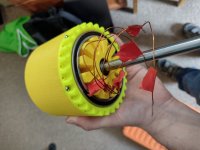My motor was run in both ways wye and delta, in delta 36kv 7A no load at 37v, in wye 21kv 4.1A no load at 37v.
Care must be taken when making the delta connection, so that all coils pull/push in the same direction.
Now about drive pattern, delta motors can be driven in push or pull mode (pull or push the magnets) , wye motors have 2 coils that are energized one puls one pushes, but delta has only one coil energized witch can pull or push, and that gives diferent results depending on motor. Another important thing in sensored mode delta and wye drive patterns are different, furthermore in wye, in order to reverse rotation 2 phases can be swapped, or switch polarity of the driven coil in the drive pattern (software), but in delta it does NOT work the same way, in order to reverse rotation all 3 phases must be swapped in a certain way, or a certain different coil must be energized in sw. So the delta motor can be runn in 4 ways, 1 push and 1pull in CW rotation and 1push and 1 pull in CCW rotation. Thrust me, i know this, because i bashed my head a few months experimenting and drawing conclusions, all information out there on the "interweb" is about wye motors they are much more simple to drive, no one talks about delta drive pattern.
All upward of 15Kw motors for aero use that i have seen are delta terminated, and this is because fewer turns are needed to achive same Kv, and winding has smaller resistence (lower losses).
Now about the BEMF waveform, depending on winding scheme and pole pairs it can be trapezoidal or sinusoidal, and if i remember correctly delta or wye termination also affects that, but i have to check that.
Edit here, typo:
Sensorless controllers have a tough time controlling delta motors, i tried on my motor, on wye was walk in the park for a sensorless ESC, but in delta it was hard to start and sometimes would lose sinchronisation.



